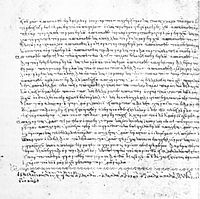Minuscule 33
|
New Testament manuscript |
|

Folio 100 verso
|
|
| Text | New Testament (except Rev) |
|---|---|
| Date | 9th century |
| Script | Greek |
| Now at | National Library of France |
| Size | 37.5 cm by 24.8 cm |
| Type | Alexandrian text-type |
| Category | I/II |
| Note | Matthew 21:44 omitted marginalia |
Minuscule 33 (in the Gregory-Aland numbering), δ 48 (Soden), before French Revolution was called Codex Colbertinus 2844. It is a Greek minuscule manuscript of the New Testament on parchment, dated palaeographically to the 9th century. The manuscript is lacunose. It has marginalia. According to the textual critics it is one of the best minuscule manuscripts of the New Testament.
The codex contains part of the Prophets of the Old Testament, and all the books of the New Testament (except Revelation of John), on 143 parchment leaves (37.5 cm by 24.8 cm), with three lacunae in Gospel of Mark, and Gospel of Luke (Mark 9:31-11:11; 13:11-14:60; Luke 21:38-23:26).
The text is divided according to the κεφαλαια (chapters), whose numerals are given at the margin, and the τίτλοι (titles of chapters) at the top of the pages.
It contains Prolegomena to the Catholic epistles and the Pauline epistles (folios 73-76), the Euthalian Apparatus.
It is written on a parchment in minuscule, in 1 column per page, 48-52 lines per page. Part of almost of every leaf has been destroyed by dampness. The leaves were joined so firmly to each other — especially in the Book of Acts — that when separated, a part of the ink has adhered to the opposite page. Text is with errors of iotacism. The ends of the leaves are much damaged.
The order of books: Gospels, Acts, Catholic epistles, Pauline epistles (Hebrews placed before 1 Timothy). Ending of the Epistle to the Romans has the following order of verses: 16:23; 16:25-27; 16:24 (as in codices P 104 256 263 365 436 459 1319 1573 1852 arm).
...
Wikipedia
